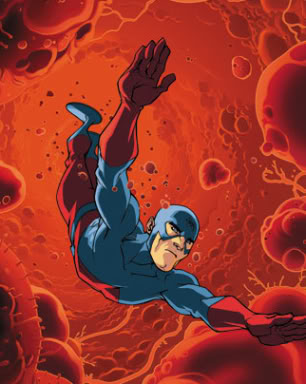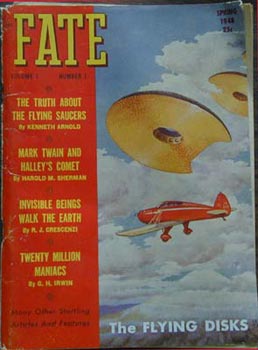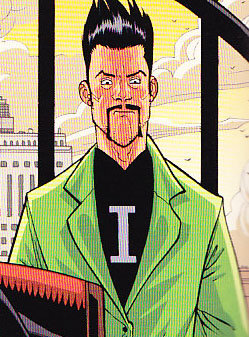 So I’m all up in this book the other day, stuck in the car for a few hours and just paging through some words when I learn something incredible. Carl Sagan, general science dude of awesome, was disappointed with his public school education (SHOCKING!) but found himself heavily influenced by science fiction and comics (he even posits Mr. Mxyzptlk as an explanation for UFO sightings). One such periodical that kept his mind working until he was ready for college was Amazing Stories editing by a man named Ray Palmer. You may now be thinking: Wait a tick, isn’t Ray Palmer the alter ego of The Atom. Well you’d be correct! Ray Palmer is indeed the Atom and was consciously named after the sci-fi editor who inspired Dr. Sagan.
So I’m all up in this book the other day, stuck in the car for a few hours and just paging through some words when I learn something incredible. Carl Sagan, general science dude of awesome, was disappointed with his public school education (SHOCKING!) but found himself heavily influenced by science fiction and comics (he even posits Mr. Mxyzptlk as an explanation for UFO sightings). One such periodical that kept his mind working until he was ready for college was Amazing Stories editing by a man named Ray Palmer. You may now be thinking: Wait a tick, isn’t Ray Palmer the alter ego of The Atom. Well you’d be correct! Ray Palmer is indeed the Atom and was consciously named after the sci-fi editor who inspired Dr. Sagan.
Allow me a quick digression before delving into some of the particulars of Palmer’s life. Many of my columns nitpick the science of comics, finding fault and inconsistency for the mere sake of flexing some mental muscles. I try to keep this all in a positive light, saying that it’s just another way for the inquisitive among our community to pry another layer of meaning off the stacks of our funnybooks. Well here’s another benefit of the sci-fi craziness provided by our sequential story addiction: inspiration. While Sagan was busy being taught facts and rote memorization in school, his mind was being allowed to soar as he pored over the latest issue of Superman. If not for comics and the scientific themes they glorify he may not have had the inspiration to pursue science at all. We would have been without one of the most influential scientific voices of the last generation. Many astronomer and other scientists readily admit to being influenced by Sagan to pursue science themselves. It’s an undeniable cascade brought forth by the awe inspiring wonder sci-fi provides. Pretty neat stuff.
 With that out of the way I can continue to Amaze you with Stories about the real Ray Palmer. The big (sort of) thing is he was 4 feet tall. Yep, Gardner Fox (creator of The Atom), named his shrinking scientists after a shrunken sci-fi editor. The origin of the miniature stature of the Earth Prime Ray Palmer reads more like Daredevil than the Earth-1 professor. Young Ray Palmer Prime was hit by a truck at the age of 7. The damage done by this accident stunted his growth so that he was never an inch over 4 feet tall, and was even a hunchback to boot.
With that out of the way I can continue to Amaze you with Stories about the real Ray Palmer. The big (sort of) thing is he was 4 feet tall. Yep, Gardner Fox (creator of The Atom), named his shrinking scientists after a shrunken sci-fi editor. The origin of the miniature stature of the Earth Prime Ray Palmer reads more like Daredevil than the Earth-1 professor. Young Ray Palmer Prime was hit by a truck at the age of 7. The damage done by this accident stunted his growth so that he was never an inch over 4 feet tall, and was even a hunchback to boot. One other tidbit of Mr. Palmer’s (I don’t think he held a doctorate like his literary counterpart) contribution to sci-fi and comics is the idea of disc shaped alien craft visiting our planet. Some sort of “Flying Saucer.” The educated among you may scoff at this assertion knowing it was pilot Kenneth Arnold who coined the term “Flying Saucer.” However, the craft he saw were boomerang shaped yet moved through the air like a “saucer skipping across the water” which was later widely misreported as saucer shaped craft. And Palmer’s ideas predated the incident anyways. I really did just think that was neat and worth pointing out.
One other tidbit of Mr. Palmer’s (I don’t think he held a doctorate like his literary counterpart) contribution to sci-fi and comics is the idea of disc shaped alien craft visiting our planet. Some sort of “Flying Saucer.” The educated among you may scoff at this assertion knowing it was pilot Kenneth Arnold who coined the term “Flying Saucer.” However, the craft he saw were boomerang shaped yet moved through the air like a “saucer skipping across the water” which was later widely misreported as saucer shaped craft. And Palmer’s ideas predated the incident anyways. I really did just think that was neat and worth pointing out.
I’m not sure if he was honored or insulted by his namesake. Think about the modern corollary. What if within the next generation of comic writers someone created a short bald talkative Jewish superhero called The Cleveland Clobberer (later changed to the Portland Pounder) who’s secret identity was Brian Michael Bendis. That’s basically what happened here. John Siuntres, I expect you to find out if this would be an honorific or an affront in your next edition of the Bendis Tapes and get back to me. For the purposes of this experiment we all agree to assume that whatever Bendis says is exactly how Ray Palmer felt in 1961.
 The other readily apparent example of a science hero (really a villain) modeled after a real live human being is the duplicitous Isotope, the besuited high-topped teleporter from Robert Kirkman’s Invincible. What living character could possibly inspire such an outlandish rogue? Why it’s James Sime of the Isotope Comics Lounge! In the letter comics it was stated that the resemblance is coincidental but methinks this was tongue in cheek at best. This isn’t even the first time Mr. Sime has appeared in a Kirkman comic.
The other readily apparent example of a science hero (really a villain) modeled after a real live human being is the duplicitous Isotope, the besuited high-topped teleporter from Robert Kirkman’s Invincible. What living character could possibly inspire such an outlandish rogue? Why it’s James Sime of the Isotope Comics Lounge! In the letter comics it was stated that the resemblance is coincidental but methinks this was tongue in cheek at best. This isn’t even the first time Mr. Sime has appeared in a Kirkman comic.
Well where’s the science in all this? Good question! (I’ve been teaching undergrads, I try to be encouraging.) Well there’s not so much science as there is need for clarification. Isotopes are a type of atom that has a more or less than usual number of neutrons. Neutrons are (unsurprisingly) neutral in charge so they don’t change the identity of the atom. Identity is determined by the number of protons. Isotopes are useful to scientists for all kinds of reasons. Some isotopes are stable, meaning they don’t decay. These are useful, but its’ complicated, so if you want clarification e-mail me or listen to the show. Other isotopes are unstable, i.e. radioactive. They’re shooting off all kinds of subatomic particles like jerks. Decaying into other atoms all predictable like and junk. That predictability acts as a sort of clock, if we know how often they break down, then we can time events based on what we see in closed systems containing those elements. So far Isotope h as shown the ability to be conniving and teleport. I’m not really sure how that applies to actual Isotopes, which is yet another reason I suspect the character is more than mere artistic coincidence.
as shown the ability to be conniving and teleport. I’m not really sure how that applies to actual Isotopes, which is yet another reason I suspect the character is more than mere artistic coincidence.
 as shown the ability to be conniving and teleport. I’m not really sure how that applies to actual Isotopes, which is yet another reason I suspect the character is more than mere artistic coincidence.
as shown the ability to be conniving and teleport. I’m not really sure how that applies to actual Isotopes, which is yet another reason I suspect the character is more than mere artistic coincidence.
As I’ve mentioned before, quantum physics is a really funky and counterintuitive realm to explore, which is one of the reasons its oft use an explanation for wonky powers outside reality. However, isotopes aren’t about quantum science, its basic atomic science. I will default to my happy place of “Man, he’s a cool looking character based off a dude I know, who cares if it makes sense?”
That’s it for this week, if you were expecting me to have a plausible way a Professor could shrink down and go through the phone lines, I’m still working on that one. Any suggestions?
Ryan Haupt used "neat" twice in this column. Yeah, he is as big a dork as you think. If you’d like further proof, he has a podcast called Science… sort of.


Thanks for the tidbit on Carl Sagan. When I was a kid Cosmos was my favorite television program. We taped it from PBS, and I would watch the episodes again and again. Hulu has them available as well, and surprisingly the show holds up pretty well after all these years, probably because the show deals with much of the bedrock of established science, and less with speculative notions.
Quick fanboy question:
Ryan Choi is dead….Right? Or did I mishear that………..
Yes, Ryan Choi is dead.
Thankyou.
Thinking about this whole Ray Palmer and James Sime thing, made me wonder about something else.
I wonder if they could have a long/longer running comic book character with a real person. Kind of like Jerry Seinfeld or Stephen Colbert, where the character is meant to be a representation of a real person with the implicit understanding that his behavior/actions/situations/powers/whatever are fictional.
President Obama is one of the only people I can think of who fit this categorization when he was in all sorts of comic books. Some where he was just his everyday self (such as the Spider-Man book), and others where he’s either a Conan like character or a mute in a post-apocalyptic future.
Actually, this real-person-but-fake-actions hit me recently when I was watching an episode of Entourage. Seth Green was on the show as "himself", but on the show he plays himself as this incredible jerk. And at one point I kind of forgot that he was "acting" and for a second thought to myself, "Wow, Seth Green is such a douche." It only took a second to remind myself it wasn’t real, but for that briefest of time I bought the act. 🙂
I know some comic book creators have appeared in issues, Stan Lee is the first to come to mind. And I remember a tribute to Julie Swartz where he learns of the Hawkman characters (as I recall) via some aliens.
And from my childhood I recall John Byrne appearing in The Trial of Reed Richards as a witness to history, which he was expected to record…in comic book form.
But especially I recall Gardner Fox was credited with being both the real and "fictional" writer of the Jay Garick Flash stories — "real" meaning he REALLY wrote the stories, and "fictional" meaning on Earth-1 Barry Allen had read the Gardner Fox stories as if Fox wasn’t creating fiction but was instead somehow mentally hooking into the Earth-2 universe. He never actually showed up in the stories (as I remember) but was inserted into the universe in a very important way.
Oh, and staying in the realm of real people appearing as themselves in comic books (sorry, Ryan, I realize I’m bending the intent of your article a little here), I actually own a copy of What If? #11 titled "What If The Original Marvel Bullpen Had Become The Fantastic Four?"
Here’s a link to a good image of the cover:
http://media.comicvine.com/uploads/0/4/16984-2918-18915-1-what-if-_super.jpg
And here’s an interesting review:
http://www.ferretpress.com/blog/2007/05/07/way-back-machine-15/
Fun stuff.